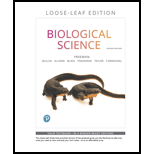
Concept explainers
What do some photosynthetic bacteria use as a source of electrons instead of water?
a. oxygen (O2)
b. hydrogen sulfide (H2S)
c. organic compounds (e.g., CH3COO–)
d. nitrate (NO3–)
Introduction:
In the photophosphorylation reaction, electrons are required. These electrons are acquired from water molecules. The molecule is split and oxygen is generated as a by-product.
Answer to Problem 1TYK
Correct answer:
Some of the photosynthetic bacteria use hydrogen sulfide (H2S) instead of water as a source of electrons.
Explanation of Solution
Explanation/Justification for the correct answer:
Option (b) is given that hydrogen sulfide is used an alternative source of energy by some photosynthetic bacteria instead of water. Some of the bacteria may not use water molecule as a source of electrons and use hydrogen sulfide instead. For example, a sulfur bacteria Thiobacillus oxidizes sulfur by sulfate production required for growth of plants. Some of them also use other different molecules such as iron ions. Hence, Option (b) is correct.
Explanation for incorrect answers:
Option (a) is given that oxygen (O2) is used an alternative source of energy by some photosynthetic bacteria instead of water. In this process, oxygen is released as a by-product and does not act as an electron source. So, it is a wrong answer.
Option (c) is given that organic compounds like acetate are used as an alternative source of energy by some photosynthetic bacteria instead of water. The organic compounds such as acetate ions also do not provide electrons. So, it is a wrong answer.
Option (d) is given that nitrate
Hence, options (a), (c), and (d) are incorrect.
Thus, some photosynthetic bacteria use hydrogen sulfide as an alternative source of energy.
Want to see more full solutions like this?
Chapter 26 Solutions
Biological Science, Loose-leaf Edition (7th Edition)
- Explain in a small summary how: What genetic information can be obtained from a Punnet square? What genetic information cannot be determined from a Punnet square? Why might a Punnet Square be beneficial to understanding genetics/inheritance?arrow_forwardIn a small summary write down:arrow_forwardNot part of a graded assignment, from a past midtermarrow_forward
- Noggin mutation: The mouse, one of the phenotypic consequences of Noggin mutationis mispatterning of the spinal cord, in the posterior region of the mouse embryo, suchthat in the hindlimb region the more ventral fates are lost, and the dorsal Pax3 domain isexpanded. (this experiment is not in the lectures).a. Hypothesis for why: What would be your hypothesis for why the ventral fatesare lost and dorsal fates expanded? Include in your answer the words notochord,BMP, SHH and either (or both of) surface ectoderm or lateral plate mesodermarrow_forwardNot part of a graded assignment, from a past midtermarrow_forwardNot part of a graded assignment, from a past midtermarrow_forward
 Concepts of BiologyBiologyISBN:9781938168116Author:Samantha Fowler, Rebecca Roush, James WisePublisher:OpenStax College
Concepts of BiologyBiologyISBN:9781938168116Author:Samantha Fowler, Rebecca Roush, James WisePublisher:OpenStax College BiochemistryBiochemistryISBN:9781305577206Author:Reginald H. Garrett, Charles M. GrishamPublisher:Cengage Learning
BiochemistryBiochemistryISBN:9781305577206Author:Reginald H. Garrett, Charles M. GrishamPublisher:Cengage Learning
 Biology (MindTap Course List)BiologyISBN:9781337392938Author:Eldra Solomon, Charles Martin, Diana W. Martin, Linda R. BergPublisher:Cengage Learning
Biology (MindTap Course List)BiologyISBN:9781337392938Author:Eldra Solomon, Charles Martin, Diana W. Martin, Linda R. BergPublisher:Cengage Learning Biology: The Unity and Diversity of Life (MindTap...BiologyISBN:9781337408332Author:Cecie Starr, Ralph Taggart, Christine Evers, Lisa StarrPublisher:Cengage Learning
Biology: The Unity and Diversity of Life (MindTap...BiologyISBN:9781337408332Author:Cecie Starr, Ralph Taggart, Christine Evers, Lisa StarrPublisher:Cengage Learning Biology: The Dynamic Science (MindTap Course List)BiologyISBN:9781305389892Author:Peter J. Russell, Paul E. Hertz, Beverly McMillanPublisher:Cengage Learning
Biology: The Dynamic Science (MindTap Course List)BiologyISBN:9781305389892Author:Peter J. Russell, Paul E. Hertz, Beverly McMillanPublisher:Cengage Learning





